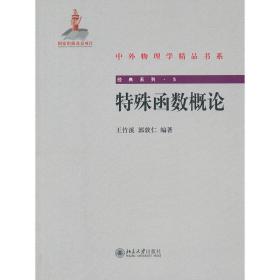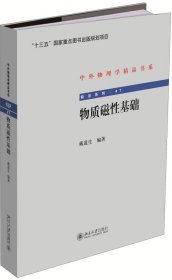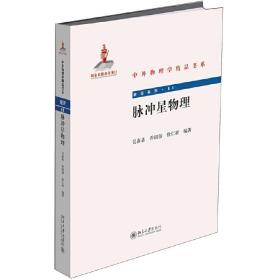
中外物理学精品书系·天文光谱学·天文光谱的原子与分子物理学导论(英文影印 第二版)
¥ 15 3.7折 ¥ 41 九品
仅1件
北京朝阳
认证卖家担保交易快速发货售后保障
作者[英]坦尼森(J.Tennyson) 著
出版社北京大学出版社
出版时间2015-01
版次1
装帧平装
货号TC1028
上书时间2024-07-01
- 在售商品 暂无
- 平均发货时间 7小时
- 好评率 暂无
- 最新上架
商品详情
- 品相描述:九品
图书标准信息
- 作者 [英]坦尼森(J.Tennyson) 著
- 出版社 北京大学出版社
- 出版时间 2015-01
- 版次 1
- ISBN 9787301251706
- 定价 41.00元
- 装帧 平装
- 开本 16开
- 纸张 胶版纸
- 页数 240页
- 字数 240千字
- 丛书 中外物理学精品书系
- 【内容简介】
-
对于宇宙的观测,其信息几乎都来自于光。观测一方面要把光分解成各种成分,另一方面也要了解原子和分子的性质。《中外物理学精品书系·天文光谱学·天文光谱的原子与分子物理学导论(英文影印 第二版)》对于这两方面都进行了系统讲述。在天文光谱学的研究中,本书能够提供丰富而实用的知识。
《中外物理学精品书系·天文光谱学·天文光谱的原子与分子物理学导论(英文影印 第二版)》适合天文学领域的研究者和研究生阅读。 - 【作者简介】
- (英)坦尼森,伦敦大学学院教授。
- 【目录】
-
Prefacev
1.WhyRecordSpectraofAstronomicalObjects?1
1.1AHistoricalIntroduction...................1
1.2WhatOneCanLearnfromStudyingSpectra........3
2.TheNatureofSpectra7
2.1Transitions............................7
2.2AbsorptionandEmission...................8
2.3OtherMeasuresofTransitionProbabilities.........10
2.4StimulatedEmission......................10
2.5OpticalDepth..........................11
2.6CriticalDensity.........................12
2.7WavelengthorFrequency?...................13
2.8TheElectromagneticSpectrum................14
3.AtomicHydrogen17
3.1Overview.............................17
3.2TheSchr¨odingerEquationofHydrogen-LikeAtoms....17
3.3ReducedMass..........................18
3.4AtomicUnits..........................19
3.5WavefunctionsforHydrogen.................20
3.6EnergyLevelsandQuantumNumbers...........21
3.7H-AtomDiscreteSpectra....................23
3.8H-AtomSpectrainDifferentLocations............29
3.8.1Balmerseries......................29
3.8.2Lymanseries......................33
3.8.3Infraredlines......................35
3.9H-AtomContinuumSpectra..................35
3.9.1Processes........................35
3.9.2H-atomemissioninHIIregions...........36
3.10RadioRecombinationLines..................38
3.11RadioRecombinationLinesforOtherAtoms........40
3.12AngularMomentumCouplingintheHydrogenAtom..43
3.13TheFineStructureofHydrogen................44
3.14HyperfineStructureintheHAtom..............45
3.15AllowedTransitions......................46
3.16HydrogeninNebulae......................47
4.ComplexAtoms51
4.1GeneralConsiderations....................51
4.2CentralFieldModel.......................52
4.3IndistinguishableParticles...................54
4.4ElectronConfigurations....................55
4.5ThePeriodicTable.......................56
4.6Ions................................58
4.7AngularMomentuminComplexAtoms...........59
4.7.1L-SorRussell-Saunderscoupling..........59
4.7.2j-jcoupling.......................61
4.7.3Whytwocouplingschemes?.............61
4.8SpectroscopicNotation.....................62
4.9ParityoftheWavefunction...................63
4.10TermsandLevelsinComplexAtoms.............64
5.HeliumSpectra69
5.1HeIandHeIISpectra......................69
5.2SelectionRulesforComplexAtoms.............71
5.3ObservingForbiddenLines..................74
5.4GrotrianDiagrams.......................75
5.5PotentialFeltbyElectronsinComplexAtoms........77
5.6EmissionsofHelium-LikeIons................78
6.AlkaliAtoms81
6.1Sodium..............................81
6.2Spin-OrbitInteractions.....................84
6.3FineStructureTransitions...................88
6.4AstronomicalSodiumSpectra.................89
6.5OtherAlkaliMetal-LikeSpectra................93
7.SpectraofNebulae99
7.1Nebulium............................100
7.2TheBowenMechanism.....................104
7.3TwoValenceElectrons.....................107
7.4AutoionisationandRecombination..............109
8.SpectrainMagneticFields115
8.1UniformMagneticField....................116
8.2StrongMagneticField.....................117
8.3WeakMagneticField......................118
8.3.1ThenormalZeemaneffect..............118
8.3.2TheanomolousZeemaneffect............119
8.4SpectrainMagneticField...................120
9.X-RaySpectra123
9.1InnerShellProcesses......................123
9.2TheSolarCorona........................127
9.3TheStructureofHighlyIonisedAtoms...........127
9.4IsotopeEffects..........................131
10.MolecularStructure135
10.1TheBorn-OppenheimerApproximation...........136
10.2ElectronicStructureofDiatomics...............137
10.2.1Labellingofelectronicstates.............140
10.2.2Symmetry........................141
10.2.3Statelabels.......................143
10.3Schr¨odingerEquation.....................144
10.3.1Nuclearmotionindiatomicmolecules.......144
10.4Fractionation...........................149
10.5Vibration-RotationEnergyLevels..............150
10.6TemperatureEffects.......................152
10.6.1Rotationalstatepopulations.............152
10.6.2Vibrationalstatepopulations.............154
10.6.3Electronicstatepopulations.............155
11.RotationalSpectra157
11.1RotationalStructureofPolyatomicMolecules........157
11.2SelectionRules:PureRotationalTransitions.........160
11.3SelectionRules.........................161
11.4IsotopeEffects..........................166
11.5RotationalSpectraofOtherMolecules............166
11.6RotationalSpectraofMolecularHydrogen.........170
11.7MaserEmissions........................170
12.Vibration-RotationSpectra175
12.1VibrationsinPolyatomicMolecules.............175
12.2VibrationalTransitions.....................177
12.2.1Structureofthespectrum...............178
12.2.2Isotopeeffects.....................181
12.2.3Hydrogenmoleculevibrationalspectra.......181
12.3AstronomicalSpectra......................183
13.ElectronicSpectraofDiatomicMolecules187
13.1ElectronicTransitions......................187
13.2SelectionRules.........................188
13.2.1Vibrationalselectionrules..............189
13.2.2Rotationalselectionrules...............190
13.3TransitionFrequencies.....................192
13.4AstronomicalSpectra......................193
13.5Non-1_ElectronicStates....................195
SolutionstoModelProblems199
FurtherReadingandBibliography215
Index217
点击展开
点击收起
相关推荐
— 没有更多了 —




























以下为对购买帮助不大的评价